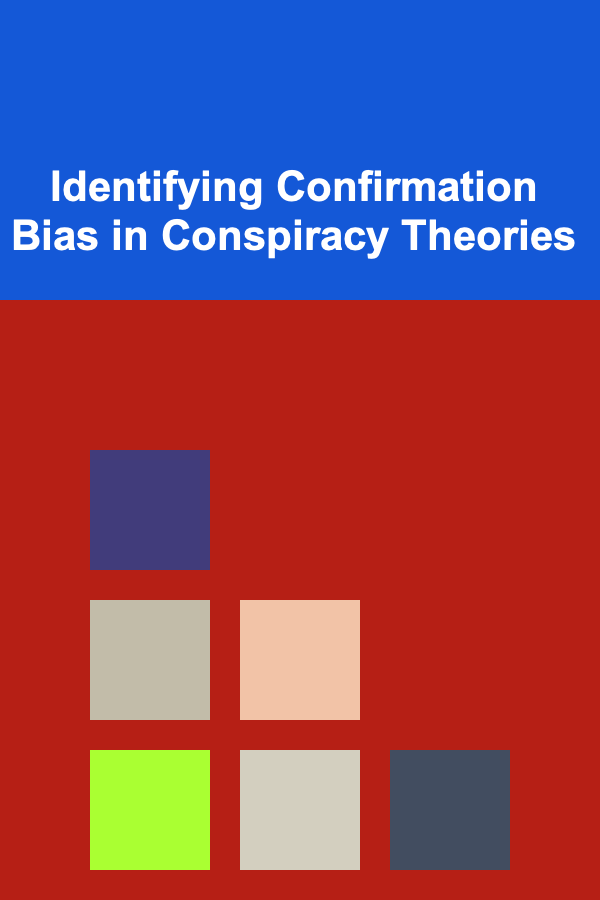
Identifying Confirmation Bias in Conspiracy Theories
ebook include PDF & Audio bundle (Micro Guide)
$12.99$6.99
Limited Time Offer! Order within the next:

Conspiracy theories, narratives that attribute significant events to secret plots by powerful and malevolent actors, are a pervasive and often polarizing feature of modern society. While skepticism and critical thinking are valuable tools for evaluating information, the allure of conspiracy theories often stems from, and is reinforced by, a powerful cognitive bias: confirmation bias. Confirmation bias, the tendency to favor information that confirms existing beliefs and dismiss information that contradicts them, plays a crucial role in both the adoption and perpetuation of conspiracy theories. Understanding how to identify confirmation bias in the context of these theories is essential for fostering more rational discourse and promoting critical evaluation of information.
Understanding Confirmation Bias: A Cognitive Foundation
At its core, confirmation bias is a fundamental flaw in human reasoning. It manifests in several ways:
- Selective Exposure: Actively seeking out information that supports existing beliefs while avoiding information that challenges them. For example, someone who believes that vaccines cause autism is more likely to read articles and watch videos that support this claim and less likely to engage with scientific research demonstrating vaccine safety and efficacy.
- Selective Interpretation: Interpreting ambiguous or neutral information in a way that confirms existing beliefs. A blurry photograph of a supposed UFO could be interpreted by a believer as undeniable proof of extraterrestrial visitation, while a skeptic might see it as a misidentified weather balloon or a photographic anomaly.
- Selective Recall: Remembering information that supports existing beliefs more readily than information that contradicts them. Memories can be reconstructed and distorted over time, and confirmation bias can influence which details are retained and emphasized.
The reasons for this cognitive bias are complex. Some theories suggest that it stems from a desire to maintain cognitive consistency and avoid the discomfort of cognitive dissonance -- the mental stress caused by holding conflicting beliefs. Others propose that it is a result of efficiency -- it is simply easier and faster to process information that aligns with what we already believe. Whatever the root cause, confirmation bias is a powerful force that can significantly distort our perception of reality.
Confirmation Bias as a Cornerstone of Conspiracy Theories
Conspiracy theories, by their very nature, are particularly susceptible to the influence of confirmation bias. The belief that powerful entities are secretly manipulating events often relies on a web of interconnected assumptions, circumstantial evidence, and interpretations that may be highly selective and biased. Here's how confirmation bias operates within the framework of conspiracy theories:
1. Seeking Information That Fits the Narrative
Individuals drawn to conspiracy theories often engage in selective exposure, actively seeking out sources that reinforce their beliefs. These sources may include:
- Alternative Media: Websites, blogs, and social media accounts that promote alternative viewpoints and often challenge mainstream narratives. While some alternative media outlets provide valuable perspectives, others may be unreliable sources of misinformation and disinformation, deliberately designed to spread conspiracy theories.
- Online Forums and Communities: Online forums and social media groups dedicated to specific conspiracy theories provide a space for like-minded individuals to share information, reinforce each other's beliefs, and develop a sense of community. These echo chambers can amplify confirmation bias by limiting exposure to dissenting opinions.
- Unreliable Experts: Individuals with questionable credentials or a clear bias may be presented as experts who support the conspiracy theory. These "experts" may offer interpretations of events that align with the narrative, even if they lack scientific or factual basis.
This selective consumption of information creates a feedback loop, where exposure to reinforcing evidence further solidifies the belief in the conspiracy theory, making it increasingly resistant to contradictory information.
2. Interpreting Ambiguity as Proof
Conspiracy theories often thrive on ambiguity and uncertainty. They take advantage of gaps in knowledge or unresolved questions to construct narratives that fit their pre-conceived conclusions. Confirmation bias plays a crucial role in this process by influencing how ambiguous information is interpreted.
For example, consider a major global event, such as a pandemic. There are always unknowns in the initial stages of such an event. Conspiracy theorists may interpret these unknowns as evidence of a deliberate plan, even in the absence of any concrete proof. A lack of consensus among experts might be seen as a sign of a cover-up, rather than a natural part of the scientific process. Anomalies or inconsistencies in official reports might be blown out of proportion and presented as evidence of deception.
The tendency to see patterns and connections where none exist (apophenia) further exacerbates this problem. Conspiracy theorists may find hidden meanings in seemingly random events, connecting them to their overarching narrative, even if these connections are based on tenuous evidence or pure speculation.
3. Dismissing Counter-Evidence
Perhaps the most damaging manifestation of confirmation bias in the context of conspiracy theories is the active dismissal of counter-evidence. Information that challenges the core tenets of the theory is often rejected out of hand, regardless of its source or validity.
Common strategies for dismissing counter-evidence include:
- Attacking the Source: Instead of addressing the substance of the counter-evidence, the focus is shifted to discrediting the source. Mainstream media outlets are often accused of being biased or controlled by the conspirators. Scientists and experts who debunk the theory are labelled as shills or puppets of the establishment.
- Reinterpreting the Evidence: Attempts are made to reinterpret the counter-evidence in a way that supports the conspiracy theory. For example, if a government report denies the existence of a secret project, a conspiracy theorist might argue that this denial is further proof of the project's existence, designed to mislead the public.
- Creating Ad Hoc Explanations: When faced with irrefutable counter-evidence, conspiracy theorists may create ad hoc explanations to explain away the discrepancy. These explanations are often convoluted and lack empirical support, but they serve to maintain the integrity of the core belief.
- Shifting the Burden of Proof: Rather than providing evidence to support their claims, conspiracy theorists may demand that skeptics disprove their theory. This tactic shifts the burden of proof inappropriately and places an impossible burden on those who are trying to engage in rational discussion.
This active dismissal of counter-evidence creates a self-sealing belief system, where the conspiracy theory becomes impervious to falsification. Any attempt to challenge the theory is simply incorporated into the narrative as further proof of the conspiracy's reach and power.
Identifying Confirmation Bias in Conspiracy Theories: Practical Strategies
Recognizing confirmation bias is the first step towards breaking free from its influence. Here are some practical strategies for identifying confirmation bias in the context of conspiracy theories:
1. Evaluate Sources Critically
The first and most important step is to critically evaluate the sources of information being used to support the conspiracy theory. Ask yourself:
- Is the source reliable? Does the source have a reputation for accuracy and objectivity? Is it a credible news organization, a peer-reviewed scientific journal, or a reputable research institution?
- Is the source biased? Does the source have a vested interest in promoting a particular viewpoint? Are they affiliated with a political party, a lobbying group, or an organization that stands to benefit from the conspiracy theory being believed?
- Is the source transparent? Does the source disclose its funding sources and potential conflicts of interest? Is it clear who is responsible for the content being published?
- Does the source provide evidence for its claims? Are the claims supported by verifiable facts, data, or expert testimony? Or are they based on speculation, conjecture, or unsubstantiated rumors?
Be wary of sources that rely on anonymous sources, sensational headlines, and emotional appeals. Cross-reference information from multiple sources to get a more balanced perspective. Look for evidence that supports or contradicts the claims being made.
2. Consider Alternative Explanations
Conspiracy theories often present a single, simplistic explanation for complex events. Challenge this narrow perspective by considering alternative explanations. Ask yourself:
- Are there other plausible explanations for the event? Could the event have been caused by natural disasters, human error, or unintentional consequences?
- Are there simpler explanations that require fewer assumptions? Occam's razor, the principle that the simplest explanation is usually the best, can be a useful tool for evaluating conspiracy theories.
- What evidence would be needed to disprove the conspiracy theory? If the theory is unfalsifiable -- that is, if there is no possible evidence that could disprove it -- then it is likely based on flawed reasoning.
By considering alternative explanations, you can avoid jumping to conclusions based on limited or biased information.
3. Look for Evidence of Selective Interpretation
Pay attention to how ambiguous information is being interpreted to support the conspiracy theory. Ask yourself:
- Is the information being presented in a balanced and objective way? Or is it being selectively presented to support a pre-determined conclusion?
- Are alternative interpretations being considered and addressed? Or are they being ignored or dismissed out of hand?
- Are there any signs of cherry-picking evidence? Is evidence that contradicts the theory being ignored or downplayed?
Be skeptical of interpretations that rely on convoluted logic, speculation, or unsupported assumptions.
4. Be Aware of Emotional Appeals
Conspiracy theories often rely on emotional appeals to persuade people to believe them. These appeals may include:
- Fear: Playing on people's fears about threats to their safety, security, or way of life.
- Anger: Inciting anger and resentment towards the alleged conspirators.
- Patriotism: Appealing to people's sense of national pride and duty.
- Distrust: Fostering distrust of authority figures and institutions.
When evaluating a conspiracy theory, try to separate your emotions from your reasoning. Focus on the facts and evidence, rather than the emotional appeals being used to persuade you.
5. Examine Your Own Biases
Finally, it is important to examine your own biases and preconceived notions. Everyone is susceptible to confirmation bias, so it is crucial to be aware of your own tendencies to favor information that confirms your existing beliefs. Ask yourself:
- Do I have any pre-existing beliefs that might influence my interpretation of the information?
- Am I open to considering alternative viewpoints?
- Am I willing to change my mind if presented with compelling evidence?
By being aware of your own biases, you can be more objective in your evaluation of information and less likely to fall prey to confirmation bias.
The Importance of Intellectual Humility
Combating confirmation bias in the realm of conspiracy theories also requires intellectual humility. This means acknowledging the limits of your own knowledge and being willing to admit that you might be wrong. It involves:
- Acknowledging Uncertainty: Recognizing that not all questions have definitive answers and being comfortable with ambiguity.
- Being Open to New Information: Actively seeking out diverse perspectives and being willing to consider evidence that challenges your beliefs.
- Respecting Different Viewpoints: Engaging in respectful dialogue with people who hold different beliefs, even if you disagree with them.
Intellectual humility fosters a more open and critical mindset, making it less likely that you will be swayed by confirmation bias and more likely that you will arrive at a more accurate understanding of the world.
Conclusion
Confirmation bias is a powerful cognitive force that can significantly distort our perception of reality, particularly in the context of conspiracy theories. By understanding how confirmation bias operates, learning to identify its manifestations, and adopting strategies for mitigating its influence, we can become more critical thinkers and more informed citizens. The ability to evaluate information objectively, to consider alternative explanations, and to acknowledge the limits of our own knowledge is essential for navigating the complex and often confusing information landscape of the 21st century. Cultivating intellectual humility and promoting rational discourse are vital steps in combating the spread of misinformation and fostering a more informed and enlightened society.

How to Leverage Robo-Advisors for Automated Investment Growth
Read More
How to Make a Checklist for Introducing Your Product to New Customers
Read More
How to Profit from Your Expertise
Read More
How To Master Social Media Marketing for POD
Read More
How to Reduce Emissions from Agriculture
Read More
Finding Artists Blending Traditional and Modern Sounds: A Comprehensive Guide
Read MoreOther Products

How to Leverage Robo-Advisors for Automated Investment Growth
Read More
How to Make a Checklist for Introducing Your Product to New Customers
Read More
How to Profit from Your Expertise
Read More
How To Master Social Media Marketing for POD
Read More
How to Reduce Emissions from Agriculture
Read More